2011 Humpback Chub Translocations to Havasu and Shinumo CreeksAllyson Mathis, Emily Omana Smith
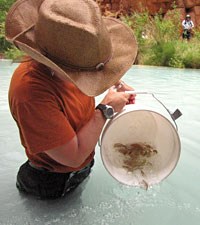
Young fish were caught in the Little Colorado River in 2010 and released in sections of the two streams that provide appropriate habitat for the fish. Humpback chub translocations began in 2009 in Shinumo Creek when 302 young humpback chub were released there.
Three hundred additional humpback chub were translocated to Shinumo Creek last year followed by another 300 this summer. The subsequent June 2011 translocation of 243 young humpback chub was the first of thre planned releases in Havasu Creek. 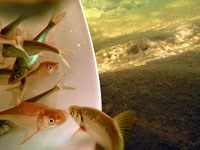
The fish are threatened by human-caused changes to the Colorado River, including the presence of non-native rainbow and brown trout.
Tributary translocations are a multi-faceted recovery tool for native fish. First, they may lead to the establishment of additional spawning populations of humpback chub in Grand Canyon, thereby increasing the species' odds of survival in the canyon. Tributaries also provide rearing, or grow-out, habitat for young chub. Fish that are larger when they reach the river have a greater chance of survival due to their increased size and may add to the number of humpback chub that live in the Colorado River itself.
Martha Hahn, Chief of Science and Resource Management at Grand Canyon National Park, said, "Translocation of humpback chub into Havasu Creek as the second drainage for translocation in Grand Canyon National Park will help us better understand the role that tributaries can play in the recovery of the species. The results from Shinumo Creek have been encouraging to date, and I'm excited to see how well the young chub in Havasu Creek do."
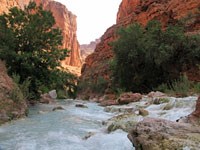
Havasu Creek is very similar to the Little Colorado River, where most humpback chub are found. Its water quality, stream characteristics, and available food base closely matches that of the Little Colorado River, making it an ideal location to expand on the translocation effort that began in Shinumo Creek. The Havasu Creek translocation site is below Beaver Falls inside of park boundaries. 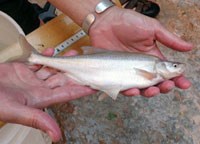
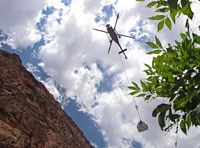
Logistics of the fisheries work in Havasu Creek are designed to minimize interference with boaters at the mouth of Havasu Creek and with the wilderness characteristics of the area. For field work, crews are either dropped off at the mouth by an already-scheduled river trip and hike out to Hualapai Hilltop, or hike in and out of the field site. Helicopter transport of the humpback chub was determined to have the least impact to park resources and visitor experience, while minimizing stress to the fish. Monitoring of Havasu Creek will next take place in October. 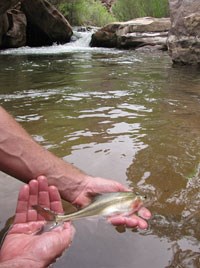
The third translocation of humpback chub to Shinumo Creek occurred on June 21, one week prior to the Havasu translocation. A total of 902 humpback chub have been released in Shinumo Creek to date. Data are currently being analyzed and they provide early insights into the success of the translocations to date. Humpback chub released in 2009 and 2010 have been recaptured by fisheries crews during monitoring work in Shinumo Creek. Data on each fish, including size and weight, is collected prior to releasing the fish back into the stream, and studies are underway on the stream ecology of Shinumo Creek. 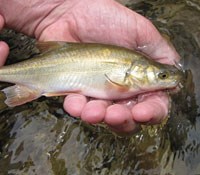
Hahn said, "I was with the field crew during the monitoring in Shinumo Creek in June. It was heartening to see that some of the chub translocated in 2009 and 2010 were already starting to develop little humps! The next milestone that we hope to see in Shinumo Creek is spawning behavior by the translocated fish." 
Approximately half of the released chub have left the creek since translocation. Most fish leave in the days immediately after translocation, which is to be expected.
However, data collected last fall show that some translocated fish that left Shinumo Creek are still alive in the Colorado River. In September 2010, biologists from Grand Canyon Research and Monitoring Center and U.S. Fish and Wildlife Service captured 27 chub from the Shinumo translocation in the Colorado River. These 27 chub made up 28% of all tagged humpback chub captured in the river suggesting that while the absolute number is small, these fish may ultimately have a significant impact of humpback chub numbers in Grand Canyon. Additionally, these fish also appear to be maintaining the higher growth rate that they had in Shinumo Creek. The NPS is currently determining if additional translocations will occur in Shinumo Creek.
The translocations to Shinumo and Havasu Creeks are part of a collaborative native fish recovery effort, led by the National Park Service (NPS), in cooperation with the U.S. Bureau of Reclamation (BOR), the U.S. Fish and Wildlife Service (USFWS), Arizona Game and Fish Department (AGFD), the U.S. Geological Survey (USGS), the University of Missouri (UM), and other partners.
To watch a video on the 2010 translocation in Shinumo Creek: https://www.nps.gov/grca/naturescience/cynsk-v21.htm Return to the Canyon Sketches Index Page. |
Last updated: February 24, 2015
